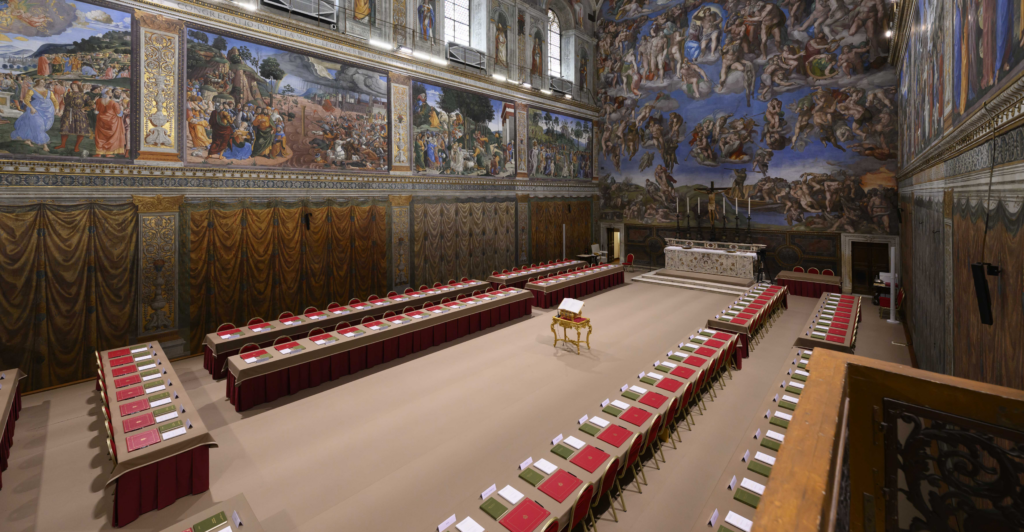Picking a New Pope: How the Selection Conclave Works
The Catholic College of Cardinals, convening in Rome on Wednesday, has begun its process of electing the next pope following the death of Pope Francis... Read More The post Picking a New Pope: How the Selection Conclave Works appeared first on The Daily Signal.

The Catholic College of Cardinals, convening in Rome on Wednesday, has begun its process of electing the next pope following the death of Pope Francis on April 21.
The electoral process, known as a conclave, will take place primarily in the Sistine Chapel within the Vatican City state.
Only voting-age cardinals—those under the age of 80—take part in the election of the new pope, and the actual election process is closed to anyone not able to participate.
The Vatican has in recent years gone to great lengths to preserve the secrecy of the conclave, sweeping for surveillance devices and instituting signal jammers when the cardinals are meeting. The efforts are not without reason. It has been alleged that the U.S.’s National Security Agency surveilled the Vatican leading up to the previous conclave in March 2013. The State Department had also reportedly kept tabs on Cardinal Jorge Bergoglio years before he was elected as Francis.
Mario Enzler, a former Swiss Guard who protected Pope John Paul II and recently visited Rome, told The Daily Signal that the “tension in Rome was palpable.”
Nevertheless, Enzler said that he was “confident the new pope will be elected according to our Lord’s heart for the good of the world.”
The actual conclave is presided over by the most senior cardinal eligible to vote. In this case, it is Cardinal Pietro Parolin, who is also reputedly a contender to succeed Francis. The cardinals use paper ballots, which are counted by six cardinals chosen by lots.
Each rectangular ballot has on it the Latin phrase, “Eligo in Summum Pontificem,” which translates to “I elect as Supreme Pontiff,” and a blank space below where the cardinal writes in the name of his chosen candidate. The ballot is then folded in half, a procedure mandated by the Apostolic Constitution Universi Dominici Gregis.
Once the ballots are counted, they are put in a stove connected to a temporary chimney on the roof of the chapel. Another stove is connected to the chimney, which is given chemicals during the burning of the ballots to produce either black or white smoke. Black smoke indicates no candidate has yet received the requisite two-thirds majority vote, while white smoke announces to the world that the cardinals have chosen a new pontiff.
Smoke was first used during a 1914 conclave, and the specific cast-iron stove has been used since 1939.
During the current conclave there are 133 electors, which means the successful candidate will need at least 89 votes. The shortlist to be the next pope includes cardinals from all across the world.
If a candidate is not elected on the first ballot, which is typically the case in modern times, then the cardinals will proceed with two rounds of voting in the morning and afternoon the following day. This process continues for three days, at which point the cardinals take a day off for prayer and reflection if no candidate has emerged as the victor. The voting then resumes, and measures are taken to limit the candidates over time.
A conclave has not exceeded four days since 1831. The cardinals are sequestered in the Vatican, away from the news and surrendering their cellphones, and away from nonessential personnel during the conclave. For the duration of the election, they live in the Domus Sanctae Marthae, a sort of hotel within the Vatican.
After the successful election, the new pope is taken to the so-called “Room of Tears,” where he puts on his white vestments for the first time. The room takes its name from the tears said to have been shed by some previous popes from the weight of their election.
St. Peter’s Basilica will have its bells rung once the new pope has been chosen. The new pontiff will then be formally introduced to the rest of the world from the central balcony of St. Peter’s Basilica with the famous words “Habemus papam,” which translates to “We have a pope.”
The post Picking a New Pope: How the Selection Conclave Works appeared first on The Daily Signal.










